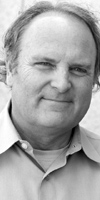
Surveys
DJC.COM
June 26, 2008
Green building’s future lies in innovation, conservation
Freehold Group

Thompson
|
Building green is about creating places that are worth making and worth keeping for the long run. It’s about designing buildings for both specific locations and non-specific uses, and it’s about conserving the resources of our planet.
When we formed Freehold 18 years ago, we put together two words that described the way we practice the art of development. For us, the word “free” represents innovation and “hold” equates to conservation, two concepts that go hand in hand. By paying attention to what has come before and eagerly embracing that which is new, we can create sustainable and lasting projects. We choose to develop in urban areas and seek out places that not only challenge the way we think, but also inspire creativity.
This set of guiding principles led us to Interbay, a dormant, underutilized and underserved area close to Seattle’s downtown core.
Serving as the link between Magnolia and Queen Anne and encompassing the 15th Avenue Northwest arterial that connects to Ballard to the north and downtown to the south, Interbay is being transformed into a vibrant in-city neighborhood with a broad mix of uses. What was once, before World War II, a residential neighborhood surrounding the old Interbay School is now emerging, after decades of decline, as one of the most unique development opportunities within our city.
Interbay has the potential to be a model neighborhood through relevant, creative and sustainable development. Currently, one-third of the 22 acres at Interbay sits vacant. Within existing buildings, approximately 40 percent of the space serves industrial tenants, 40 percent is used as office space and 20 percent is retail. It’s one of the unique mixes within this region, with one exception: There is no housing. Indeed, there is only one resident in Interbay.
To ensure a successful future, the Interbay neighborhood must embrace smart, sustainable and green development.
Green location
Green building is about embracing a location and considering how people can benefit the most from its development. We all know the mantra — location, location, location. Today this is more relevant than ever. As we plan for growth, invest in mass transit and build green for the environment and community, location is the most important part of sustainable and responsible development. Interbay is located just minutes from the city center; is served by bike paths, Metro and future bus rapid transit; and is walkable from downtown, Queen Anne, Magnolia and Ballard. The location shouts out for urban renewal.
Green plan
A neighborhood is more than just a place for passing through or a place on the way to somewhere else. It’s a destination, a place to be at work, to be together with others, a place to be at home. The members of the Interbay Neighborhood Association have relied on these principles in creating Interbay’s neighborhood master plan, and a great plan leads to environmental stewardship and sustainable development. Together we are creating a neighborhood that will thrive for generations to come.
Green flexibility
From the start, we have actively preserved and reused buildings in Interbay, with the tacit acknowledgment that adaptive reuse is one of the greenest building practices. For example, the Interbay Building, once nearly abandoned, is now home to 200 high-paying jobs. Soon we’ll begin reconstruction on the Bow Building. Though outdated for industry, the building will house remarkable space for creative businesses. With these and other nearby projects, we will have reused and revitalized more than 100,000 square feet in the Interbay neighborhood.
Green relevance
When building new, our intent is to leave the land better than we found it and add value to the surrounding community. Our goals include maximizing natural light, considering our neighbors and making places where we would all love to be.
Our first new building in Interbay is called the Nitty Gritty. Located in the center of Interbay, the Nitty Gritty represents the new spirit of this place and will form the heart of this emerging neighborhood. Like Interbay, it is a mix of industrial, office and retail uses — the Nitty Gritty will include 74,000 square feet of office/lab space, 23,500 square feet of retail shops and restaurants, 9,700 square feet of industrial space, a 16,000-square-foot rooftop garden and a large “uncommon” public area open to the sun and to the community.
Topping off Nitty Gritty is an innovative green roof. As part of reclaiming the land, this garden in the air will feed diners in the restaurants below. As a roof, it will save energy, delight the pedestrian, enhance views from Queen Anne and Magnolia, green the adjacent office space and provide an urban farm.
This is the future of building. Innovation and conservation, hand in hand.
Jeff Thompson is a principal of Freehold Group, a real estate development company based in Seattle. Founded 18 years ago, the firm is active in the creation and ownership of residential, retail, office, technology and industrial properties.
Other Stories:
- Corporate social responsibility turns green
- A green approach to gold mining in the Okanogan
- Financing evolves to benefit the environment
- Homeowners rethink their waterfronts
- Will Earthships save the Earth?
- Municipalities discover the benefits of eco-roofs
- What lies ahead for sustainable design?
- Planning our communities for a low-carbon future
- City, tribe team up on clean water project
- Architectural firm sets a zero-energy goal
- New stormwater discharge challenges loom
- Seattle becomes a hotbed for clean technologies
- Speed up sustainable development with a planned-action EIS
- Avoiding fish-related construction delays
Copyright ©2009 Seattle Daily Journal and DJC.COM.
Comments? Questions? Contact us.